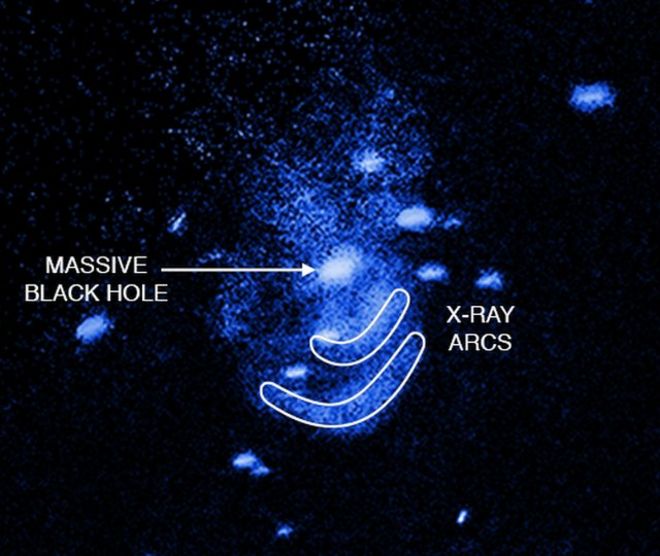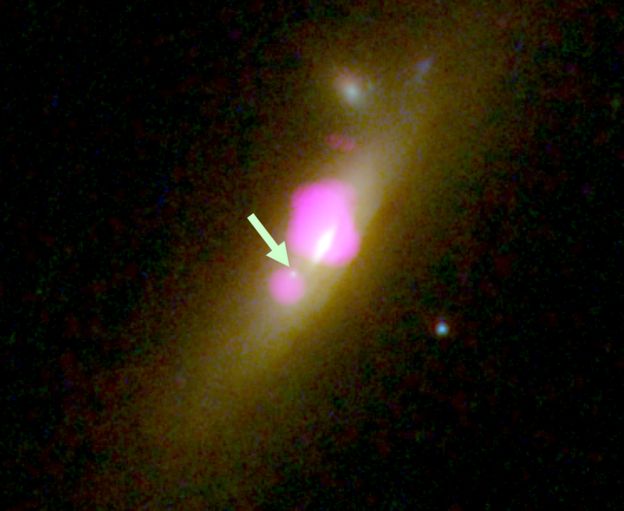Black hole caught 'burping' galactic gas supply

Astronomers have spotted two huge waves of gas being "burped" by the black hole at the heart of a nearby galaxy.
The swathes of hot gas, detected in X-ray images from Nasa's Chandra space telescope, appear to be sweeping cooler hydrogen gas ahead of them.
This vast, rippling belch is taking place in NGC 5194 - a small, neglected sibling of the "Whirlpool Galaxy", 26 million light years away.
That makes it one of the closest black holes blasting gas in this way.
The findings, presented at the 227th meeting of the American Astronomical Society (AAS) in Florida, are a dramatic example of "feedback" between a supermassive black hole and its host galaxy.
"We think that feedback keeps galaxies from becoming too large," said Marie Machacek, a co-author of the study from the Harvard-Smithsonian Center for Astrophysics (CFA).
"But at the same time, it can be responsible for how some stars form. This shows that black holes can create, not just destroy."
Ancient emissions
Black holes are well known for consuming gas and stars, but the two arcs of material glimpsed here are the equivalent of a burp after a big meal, the team said.
The black hole at the centre of NGC 5194 probably gorged on gas that was delivered by the small galaxy's interaction with its much bigger, spiralling neighbour. As that matter fell into the black hole, huge amounts of energy would have been released - causing the outbursts.

Eric Schlegel from the University of Texas at San Antonio, who led the study, explained that the crucial observation was the cooler hydrogen gas being propelled ahead of the hot, X-ray emitting waves.
"This is the best example of snowplough material I've ever seen," he said.
Deep red light, indicating the presence of hydrogen, was seen in a thin strip just in front of the outermost wave, in optical images from a telescope at the Kitt Peak National Observatory in Arizona.
"If it had not been for the hydrogen-alpha image, I would have been somewhat sceptical," Prof Schlegel told BBC News.
"I would have said, maybe this is mass going in, maybe it's mass coming out."
But the patch of hydrogen, spread out in a thin shape closely matching the arc of hot gas seen in Chandra X-ray images, clinched this as a belch rather than a gulp.
In fact, it is the cosmic shockwave from a rather ancient burp; the team has calculated that the inner wave of hot gas probably took three million years to reach its current position - and the outer wave up to six million years.
"We think these arcs represent fossils from two enormous blasts when the black hole expelled material outward into the galaxy," said co-author Christine Jones, also from the CFA.
"This activity is likely to have had a big effect on the galactic landscape."
If their central, supermassive black holes often blast gas outward like this, it might help explain why elliptical galaxies like NGC 5194 tend not to have much active star formation, Prof Schlegel said.
And in the meantime, the outburst is likely to give NGC 5194 (also known as Messier 51b) some of the spotlight that it normally loses to the huge, whirlpool-shaped Messier 51a, with which it is gradually colliding.
"[The Whirlpool Galaxy] gets all the attention," Prof Schlegel said. "The poor companion gets very little - but I think that's about to change."
More black hole news
Other researchers speaking at the AAS meeting on Tuesday described a different, very peculiar black hole.
It is one of a pair of supermassive black holes, circling each other within a single galaxy after a big merger event.
Remarkably, only one of the pair is surrounded by the usual bright, spherical clump of gravitationally bound stars - posing something of a mystery.
 Hubble Space Telescope/Chandra X-ray Observatory
Hubble Space Telescope/Chandra X-ray Observatory
"The answer may lie in the galaxy merger itself," said Julie Comerford, an astrophysicist at University of Colorado Boulder.
"When two galaxies merge, there are very strong gravitational and tidal forces that can strip away the stars from around the black hole."
Alternatively, the star-starved black hole may simply belong to a very rare, intermediate class - much smaller than the usual supermassive monsters that sit at the centre of big galaxies.
In that case, one of the galaxies that went into the merger must have only been a dwarf galaxy.
"Maybe this small sphere of stars is actually appropriate for an intermediate-mass black hole," said Dr Comerford.
"There are very few of these known - they are very rare and hard to find - but they're interesting because we think they may be an evolutionary stopover in the process of building supermassive black holes."
Dr Comerford and her colleagues published their findings, based on images from the Chandra and Hubble space telescopes, last year in the Astrophysical Journal.
Science news
![Science news]() Reviewed by Unknown
on
02:48:00
Rating:
Reviewed by Unknown
on
02:48:00
Rating:
No comments: